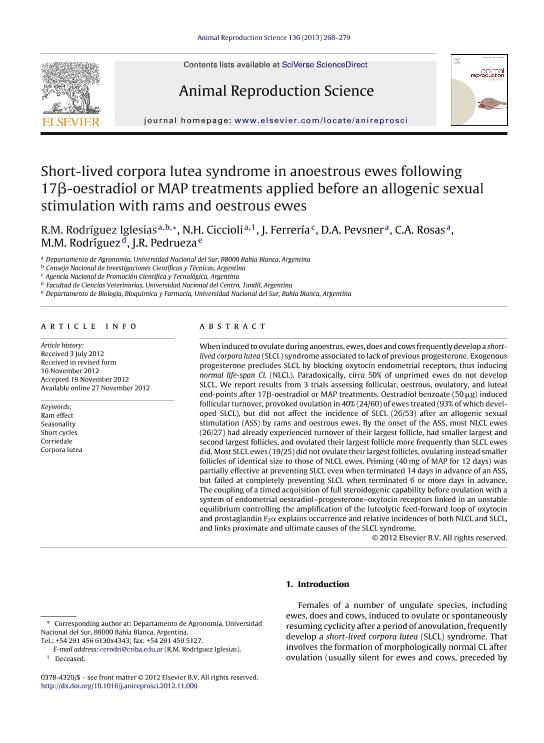Mostrar el registro sencillo del ítem
dc.contributor.author
Rodríguez Iglesias, Ricardo Manuel

dc.contributor.author
Ciccioli, N. H.
dc.contributor.author
Ferrería, J.
dc.contributor.author
Pevsner, Damián Andrés

dc.contributor.author
de Abreu Rosas, Claudia

dc.contributor.author
Rodriguez, M. M.
dc.contributor.author
Pedrueza, Jorge Raúl

dc.date.available
2017-07-28T19:55:47Z
dc.date.issued
2013-01
dc.identifier.citation
Rodríguez Iglesias, Ricardo Manuel; Ciccioli, N. H.; Ferrería, J.; Pevsner, Damián Andrés; de Abreu Rosas, Claudia; et al.; Short-lived corpora lutea syndrome in anoestrous ewes following 17β-oestradiol or MAP treatments applied before an allogenic sexual stimulation with rams and oestrous ewes; Elsevier Science; Animal Reproduction Science; 136; 4; 1-2013; 268-279
dc.identifier.issn
0378-4320
dc.identifier.uri
http://hdl.handle.net/11336/21563
dc.description.abstract
When induced to ovulate during anoestrus, ewes, does and cows frequently develop a short-lived corpora lutea (SLCL) syndrome associated to lack of previous progesterone. Exogenous progesterone precludes SLCL by blocking oxytocin endometrial receptors, thus inducing normal life-span CL (NLCL). Paradoxically, circa 50% of unprimed ewes do not develop SLCL. We report results from 3 trials assessing follicular, oestrous, ovulatory, and luteal end-points after 17β-oestradiol or MAP treatments. Oestradiol benzoate (50 μg) induced follicular turnover, provoked ovulation in 40% (24/60) of ewes treated (93% of which developed SLCL), but did not affect the incidence of SLCL (26/53) after an allogenic sexual stimulation (ASS) by rams and oestrous ewes. By the onset of the ASS, most NLCL ewes (26/27) had already experienced turnover of their largest follicle, had smaller largest and second largest follicles, and ovulated their largest follicle more frequently than SLCL ewes did. Most SLCL ewes (19/25) did not ovulate their largest follicles, ovulating instead smaller follicles of identical size to those of NLCL ewes. Priming (40 mg of MAP for 12 days) was partially effective at preventing SLCL even when terminated 14 days in advance of an ASS, but failed at completely preventing SLCL when terminated 6 or more days in advance. The coupling of a timed acquisition of full steroidogenic capability before ovulation with a system of endometrial oestradiol–progesterone–oxytocin receptors linked in an unstable equilibrium controlling the amplification of the luteolytic feed-forward loop of oxytocin and prostaglandin F2α explains occurrence and relative incidences of both NLCL and SLCL, and links proximate and ultimate causes of the SLCL syndrome.
dc.format
application/pdf
dc.language.iso
eng
dc.publisher
Elsevier Science

dc.rights
info:eu-repo/semantics/openAccess
dc.rights.uri
https://creativecommons.org/licenses/by-nc-sa/2.5/ar/
dc.subject
Ram Effect
dc.subject
Seasonality
dc.subject
Short Cycles
dc.subject
Corriedale
dc.subject
Corpora Lutea
dc.subject.classification
Biología Reproductiva

dc.subject.classification
Ciencias Biológicas

dc.subject.classification
CIENCIAS NATURALES Y EXACTAS

dc.subject.classification
Biología

dc.subject.classification
Ciencias Biológicas

dc.subject.classification
CIENCIAS NATURALES Y EXACTAS

dc.subject.classification
Otras Producción Animal y Lechería

dc.subject.classification
Producción Animal y Lechería

dc.subject.classification
CIENCIAS AGRÍCOLAS

dc.title
Short-lived corpora lutea syndrome in anoestrous ewes following 17β-oestradiol or MAP treatments applied before an allogenic sexual stimulation with rams and oestrous ewes
dc.type
info:eu-repo/semantics/article
dc.type
info:ar-repo/semantics/artículo
dc.type
info:eu-repo/semantics/publishedVersion
dc.date.updated
2017-07-28T17:53:58Z
dc.journal.volume
136
dc.journal.number
4
dc.journal.pagination
268-279
dc.journal.pais
Países Bajos

dc.journal.ciudad
Ámsterdam
dc.description.fil
Fil: Rodríguez Iglesias, Ricardo Manuel. Consejo Nacional de Investigaciones Científicas y Técnicas; Argentina. Universidad Nacional del Sur. Departamento de Agronomía; Argentina
dc.description.fil
Fil: Ciccioli, N. H.. Universidad Nacional del Sur. Departamento de Agronomía; Argentina
dc.description.fil
Fil: Ferrería, J.. Ministerio de Ciencia. Tecnología e Innovación Productiva. Agencia Nacional de Promoción Cientifíca y Tecnológica; Argentina
dc.description.fil
Fil: Pevsner, Damián Andrés. Consejo Nacional de Investigaciones Científicas y Técnicas; Argentina. Universidad Nacional del Sur. Departamento de Agronomía; Argentina
dc.description.fil
Fil: de Abreu Rosas, Claudia. Universidad Nacional del Sur. Departamento de Agronomía; Argentina
dc.description.fil
Fil: Rodriguez, M. M.. Universidad Nacional del Centro de la Provincia de Buenos Aires. Facultad de Ciencias Veterinarias; Argentina
dc.description.fil
Fil: Pedrueza, Jorge Raúl. Universidad Nacional del Sur. Departamento de Biología, Bioquímica y Farmacia; Argentina
dc.journal.title
Animal Reproduction Science

dc.relation.alternativeid
info:eu-repo/semantics/altIdentifier/url/http://www.sciencedirect.com/science/article/pii/S0378432012003740
dc.relation.alternativeid
info:eu-repo/semantics/altIdentifier/doi/http://dx.doi.org/10.1016/j.anireprosci.2012.11.009
Archivos asociados
